Schneider Shorts of 31 May 2024 – New York pharma cheater guilty, image sleuth reveals secret identity, Iranian papermillers in Germany and Switzerland, Chinese editing ring with split personalities, ACS learns COPE guidelines, with shocking editorial practices, applied Australian research ethics, and finally, an industry whistleblower gaslighted.
Table of Discontent
Science Elites
- Kevin Patrick vs Shaker Mousa – Fraudster found guilty, image sleuth reveals his secret identity
- What makes you ask me this question? – Iranian papermillers enter Swiss psychiatry
- Half-breed approach – TU Darmstadt and its Iranian climate warriors
Scholarly Publishing
- No concerns have been raised regarding other data – Mark Smyth papers simultaneously fraudulent and reliable
- Split personalities – how Chinese editors at Elsevier rig peer review
- Dear PupPeer user – ACS fully trusts Jolanda Spadavecchia
- No credible evidence of scientific fraud – Shocking use of Proofig!
Retraction Watchdogging
- Historic heavy rain and flooding – award for most stupid author explanation goes to…
- Author is deceased – Rene Aquarius kills Turkish paper
- Undeclared re-use of data – a giant retraction at PLOS One for Italian plagiarists
Industry Giants
- A complete surprise – how 3M gaslighted a PFAS whistleblower
Science Elites
Kevin Patrick vs Shaker Mousa
Curtains for the bad pharmacologist Shaker Mousa. He lost his job as professor and head of institute at University of Albany in USA, saw himself investigated by his university, his papers retracted (read October 2023 Shorts), and now HHS-ORI found him guilty of research misconduct.
Shaker Mousa – NY pharma gangsta’
Yo, what’s up, my homies, Shaker Mousa is in da house.
But first, a major announcement. Please everyone give a big round of applause to Mr Kevin Patrick. Kevin is not a professor. He doesn’t even have a PhD and he doesn’t need one because he has a life (contrary to what someone once advised him).
You may be confused now who Kevin Patrick is.
Well, he is Cheshire on Twitter and on For Better Science and Actinopolyspora biskrensis on PubPeer. In this secret life as image integrity superhero, Kevin exposed fraud by many big American scientists and pharma businesses, and Mousa is just one of them. In fact, Kevin reported Mousa for suspected research misconduct to his then-employer and HHS-ORI in the first place (and I wrote about it and reported Mousa together with his Albany patron Paul J Davis as well).
Help with another? Not on PubPeer yet
This guest post by pseudonymous Cheshire, shows that everyone can become an image integrity sleuth. You don’t need to be a scientist, just use common sense and some Twitter advice
Now, to the fraud findings by ORI, publicly announced on 28 May 2024. It addressed only two of Mousa’s papers out of OVER SIXTY on PubPeer, but that was enough to find him guilty. Here is the summary (illustrations, highlights and hyperlinks mine):
“Based on the report of an investigation conducted by Albany College of Pharmacy and Health Sciences (ACPHS) and additional analysis conducted by the Office of Research Integrity (ORI) in its oversight review, ORI found that Shaker Mousa, Ph.D., M.B.A., FACC, FACB (Respondent), who was a Professor, Chairman, and Executive Vice President of the Pharmaceutical Research Institute, ACPHS, engaged in research misconduct in research supported by U.S. Public Health Service (PHS) funds, specifically National Cancer Institute (NCI), National Institutes of Health (NIH), grant R21 CA135245 and National Institute of Diabetes and Digestive and Kidney Diseases (NIDDK), NIH, grant R01 DK052798.
ORI found that Respondent engaged in research misconduct by intentionally, knowingly, or recklessly falsifying and/or fabricating chick chorioallantoic membrane (CAM) assays used to determine angiogenesis activities of small molecules in:
- Tetraiodothyroacetic acid-conjugated PLGA nanoparticles: a nanomedicine approach to treat drug-resistant breast cancer. Nanomedicine (Lond) 2013 Dec;8(12):1943-54. doi: 10.2217/nnm.12.200 (hereafter referred to as “Nanomedicine (Lond) 2013”).
- The proangiogenic action of thyroid hormone analogue GC-1 is initiated at an integrin. J. Cardiovasc. Pharmacol. 2005 Sep;46(3):356-60. doi: 10.1097/01.fjc.0000175438.94906.a0 (hereafter referred to as “J. Cardiovasc. Pharmacol. 2005”). Retraction in: J. Cardiovasc. Pharmacol. 2023 Sep 8. doi: 10.1097/FJC.0000000000001471.
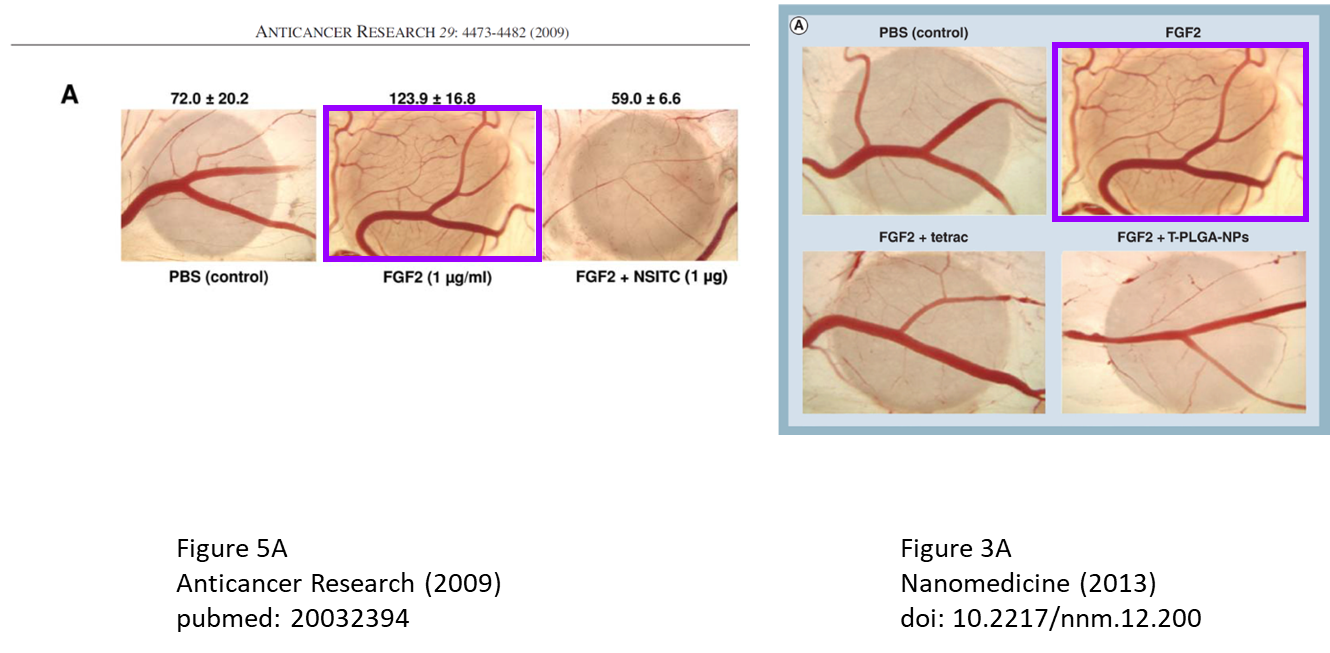
Specifically,ORI found that Respondent intentionally, knowingly, or recklessly falsified and/or fabricated:
- seven (7) micrograph panels in Nanomedicine (Lond) 2013 and J. Cardiovasc. Pharmacol. 2005 by reusing CAM images from the same source and falsely relabeling them to report pro-angiogenic factors as alternate pro-angiogenic factors, anti-angiogenic drug treatments as alternate anti-angiogenic drug treatments, and control treatments and anti-angiogenic treatments as the same treatment in:
- FGF2 images in Figure 3A of Nanomedicine (Lond) 2013 and in Figure 2A of J. Cardiovasc. Pharmacol. 2005 and GC-1 image in Figure 4A of J. Cardiovasc. Pharmacol. 2005
- FGF2 + T-PLGA-NPs image in Figure 3A in Nanomedicine (Lond) 2013 and GC-1 + XT199 image in Figure 4A of J. Cardiovasc. Pharmacol. 2005
- FGF2 + tetrac in Figure 3A of Nanomedicine (Lond) 2013 and PBS Control image in Figure 4A of J. Cardiovasc. Pharmacol. 2005
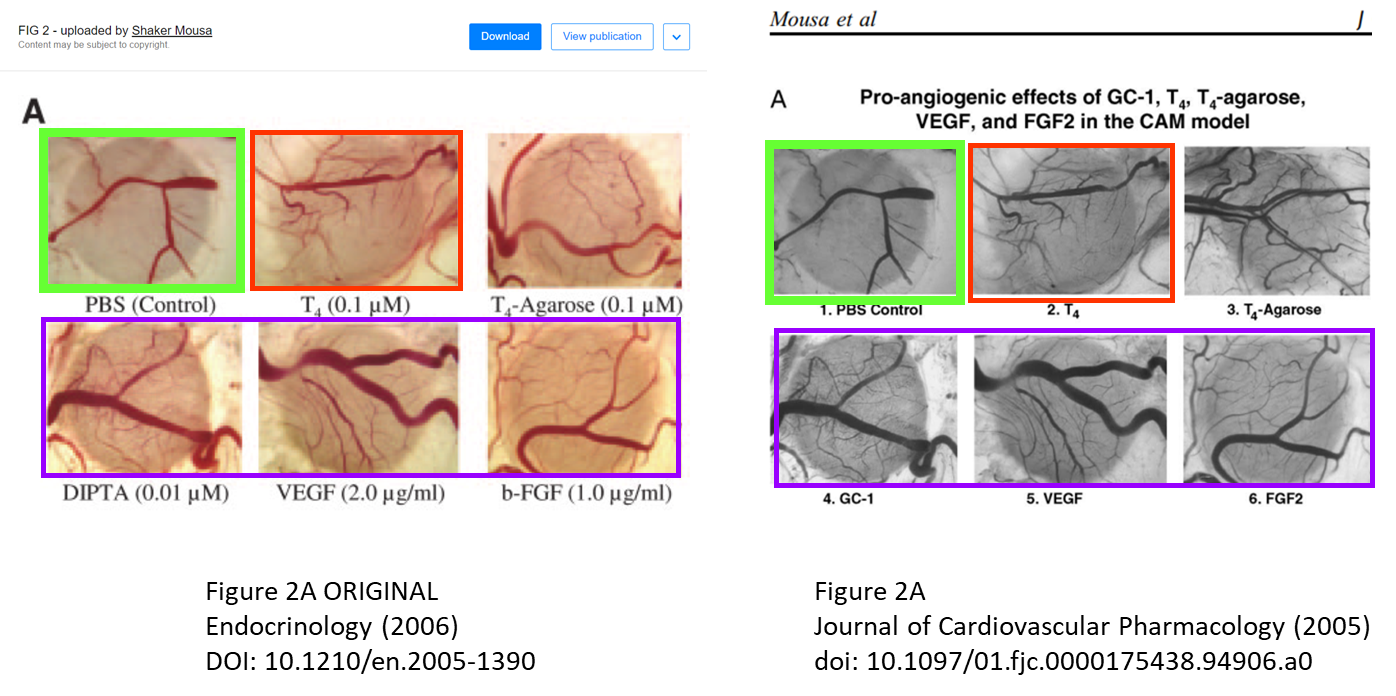
Respondent entered into a Voluntary Settlement Agreement (Agreement) and voluntarily agreed to the following:
- Respondent will have his research supervised for a period of four (4) years beginning on May 15, 2024 (the “Supervision Period”). […]
- The requirements for Respondent’s supervision plan are as follows:
- A committee of 2-3 senior faculty members at the institution […]
- The committee will conduct an advance review of each application for PHS funds, or report, manuscript, or abstract involving PHS-supported research in which Respondent is involved. […]
- During the Supervision Period, Respondent will ensure that […] a certification to ORI that the data provided by Respondent are based on actual experiments or are otherwise legitimately derived and that the data, procedures, and methodology are accurately reported in the application, report, manuscript, or abstract.
- If no supervision plan is provided to ORI, Respondent will provide certification to ORI […] that he has not participated in any capacity in PHS-supported research.
- During the Supervision Period, Respondent will exclude himself voluntarily from serving in any advisory or consultant capacity to PHS including, but not limited to, service on any PHS advisory committee, board, and/or peer review committee.
- Respondent will request that the following paper be corrected or retracted:
- Nanomedicine (Lond) 2013 Dec;8(12):1943-54. doi: 10.2217/nnm.12.200
Respondent will copy ORI and the Research Integrity Officer at ACPHS on the correspondence with the journal. “
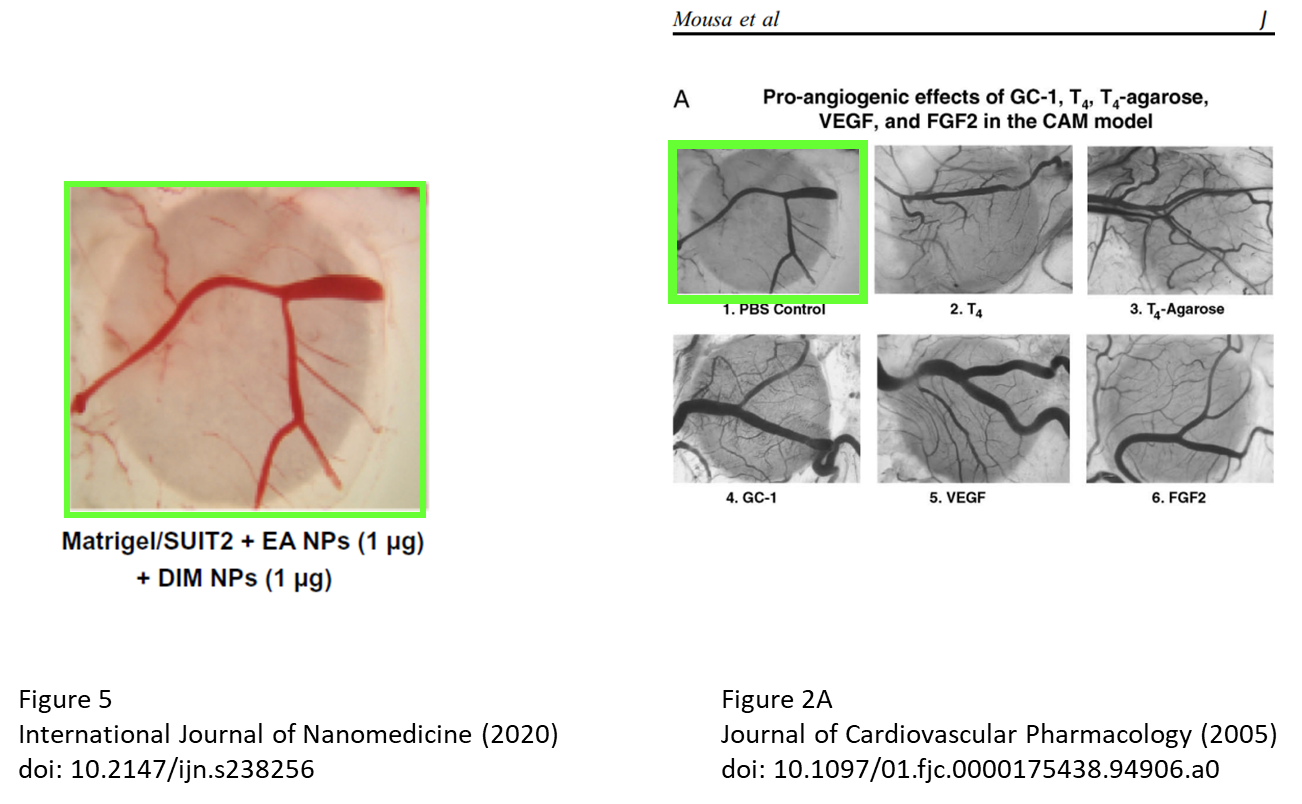
The order of four year supervision is symbolic, because Mousa pretends he retired voluntarily for health reasons. In reality he is unemployable in USA, but still valued in Egypt (read September 2023 Shorts).
Great sleuthing by Kevin Patrick, and a great finale. Wait till dr who? hears of it!
Cheshire vs Dr who?
If you follow Cheshire on Twitter, you surely heard him referencing a certain “Dr who?”. The following guest post exposes a very toxic fraudster and covidiot.
What makes you ask me this question?
In last Friday Shorts, we met Marcel Dinger, science dean of the University of Sidney in Australia who coauthored 15 papers with the Iranian papermillers Mohammad Taheri and Soudeh Ghafouri-Fard. Two days later, my most dedicated readers at Retraction Watch basically copied the story and passed it off as their own investigation, because when you appoint yourself as watchdog of publication ethics, you get to decide to whom those apply. This is by far not the first or even tenth time Retraction Watch do it. Just on 16 May they passed off as their own discovery the content of April 2024 Shorts.
Now a Swiss professor was caught papermilling with Taheri. Another Retraction Watch “Exclusive” in the making?
As reminder, Taheri is currently employed as PhD student by the University of Jena in Germany, together with Ghafouri-Fard he publishes garbage reviews citing retracted papermill garbage and insane clinical studies which lack the proper ethics approvals. You can read the full story here, revealed by Alexander Magazinov:
Look What the Cat Dragged In
Meet Mohammad Taheri, PhD, a humble PhD student in Jena, Germany, and his equally unremarkable Iranian associate Dr Soudeh Ghafouri-Fard.
Now, to the Swiss collaborator of Taheri and Ghafouri-Fard, once again discovered by Magazinov.
Our hero is Serge Brand, faculty member at the Department of Sports of the University of Basel and clinical faculty at the university’s psychiatric clinic. Here is his PubPeer record with the Iranians, in total Brand published 4 papers with them between 2021 and 2024.
Do you think a genetics study with suicide victims needs a proper ethics approval?
Soudeh Ghafouri-fard , Reyhane Eghtedarian , Elham Badrlou , Solat Eslami , Mohammad Taheri, Serge Brand Association between ACE gene polymorphisms and risk of suicide Biomarkers in Neuropsychiatry (2024) doi: 10.1016/j.bionps.2024.100087
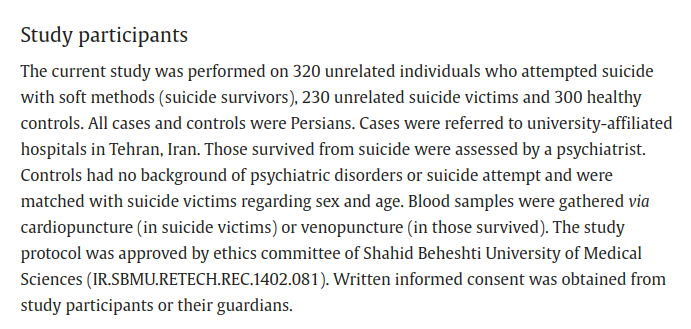
The suicide victims study is most likely fabricated anyway, Magazinov and Dorothy Bishop swiftly debunked it as nonsense. Bishop also tried to obtain the raw data this pseudoscientific autism study by Brand, Taheri and Ghafouri-Fard:
Ashkan Pourtavakoli , Soudeh Ghafouri-Fard, Solat Eslami , Serge Brand , Mohammad Taheri Expression assay of calcium signaling related lncRNAs in autism Molecular Biology Reports (2024) doi: 10.1007/s11033-023-09182-x
Ghafouri-Fard offered: “This data can be obtained through sending email (preferentially an academic email) to the corresponding author“, and then sent nothing.
Here were have not just Brand, but also his boss – the full professor, chief physician and deputy director at the Psychiatric Clinic of the University of Basel, Annette Brühl.
Soudeh Ghafouri-Fard, Reyhane Eghtedarian, Mohammad Taheri, Annette Beatrix Brühl , Dena Sadeghi-Bahmani , Serge Brand A Review on the Expression Pattern of Non-coding RNAs in Patients With Schizophrenia: With a Special Focus on Peripheral Blood as a Source of Expression Analysis Frontiers in Psychiatry (2021) doi: 10.3389/fpsyt.2021.640463
I asked Brühl how she came to collaborate with Taheri. She only replied:
“What makes you ask me this question?”
Dunno, that authoritative review paper on schizophrenia in Frontiers maybe? Brühl remained silent. Hers and Brand’s study was totally independently peer-reviewed by Taheri’s close associates Shahram Arsang-Jang and Seyed Jawad Mowla, and it heavily cites such international titans of psychiatry citation buyers like some Wei Niu. Yet another Frontiers review by Brand, Taheri and Ghafouri-Frad was also peer-reviewed by another one of Taheri’s close associates, Amin Safa.
Judging from the Dinger case, Taheri possibly also applied to Brand as PhD student, wasn’t admitted, but still generously had authorships to offer, and which red-blooded scientist can say no to that?
This is, Brand does value Iranian PhD students. One of his former mentees, the coauthor on the Taheri paper above is Dena Sadeghi-Bahmani, now postdoc in Stanford. Brand and Bahmani have no less than 23 papers common since 2017. Here another paper of them with Taheri, Ghafouri-Fard and Brühl, in MDPI:
Soudeh Ghafouri-Fard , Elham Badrlou , Mohammad Taheri , Kenneth M. Dürsteler , Annette Beatrix Brühl , Dena Sadeghi-Bahmani , Serge Brand A Comprehensive Review on the Role of Non-Coding RNAs in the Pathophysiology of Bipolar Disorder International Journal of Molecular Sciences (2021) doi: 10.3390/ijms22105156
Also, since 2021 Brand has been publishing with Habibolah Khazaie, who also must have been his PhD student. This PubPeer thread suggests that Khazaie may have engaged in papermilling (his study on genetics of erectile dysfunction features an agronomist as coauthor). It’s 21 papers by Brand and Khazaie (often with Bahmani) now, many also with Brühl. As if someone opened a door for Brand. A door to Iranian papermills?
Brand never replied. Nobody else in Basel replied to my emails. Will they reply to Retraction Watch?
Half-breed approach
Meet another shooting star from Iran: Dr Babak Aghel, until end of 2023 Alexander-von-Humboldt fellow at the TU Darmstadt in Germany. His host at the Institute for Energy Systems and Technology is Priv.-Doz. Dr.-Ing. habil. Falah Alobaid and together the two men were about to save the planet from the climate change catastrophe – they are working on CO2 capture. Aghel is now associate professor at Kermanshah University of Technology in Iran. Alobaid is since April 2024 full professor at the LUT University in Finland.
What made Aghel stand out from those other Humboldt fellowship applicants who miserably failed? His unmatched superior scientific talent of course, and look what TU Darmstadt and Humboldt Foundation got in return for their investment. Allow me to show you two papers in MDPI:
Babak Aghel, Salah I. Yahya , Abbas Rezaei , Falah Alobaid A Dynamic Recurrent Neural Network for Predicting Higher Heating Value of Biomass International Journal of Molecular Sciences (2023) doi: 10.3390/ijms24065780

As you see, Aghel’s group leader at TU Darmstadt, Falah Alobaid is also coauthor of that apparent scam. Here is their second MDPI masterpiece:
Seyyed Amirreza Abdollahi , AmirReza Andarkhor , Afham Pourahmad , Ali Hosin Alibak , Falah Alobaid , Babak Aghel Simulating and Comparing CO2/CH4 Separation Performance of Membrane–Zeolite Contactors by Cascade Neural Networks Membranes (2023) doi: 10.3390/membranes13050526

Alobaid proudly displays these two papers on his institutional profile in Darmstadt (his LUT profile is under contruction). There is a third dodgy paper which Aghel purchased submitted for publication before coming to Darmstadt, he used a Kermanshah University affiliation there. The study is about carbon capure by biogas and contains “tortured phrases” like “particle trade“, “vitality utilization“, “tall immaculateness“, “inactive warmth” or “half-breed approach“. This happens when stolen text is translated back and forth to hide plagiarism.
Babak Aghel, Sara Behaein , Somchai Wongwises , Mostafa Safdari Shadloo A review of recent progress in biogas upgrading: With emphasis on carbon capture Biomass and Bioenergy (2022) doi: 10.1016/j.biombioe.2022.106422
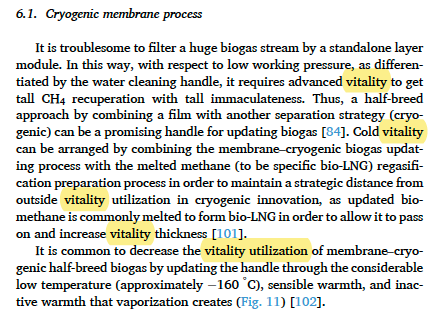


As Nick Wise found out:
“This work has plagiarised from ‘Environmental and Economic Assessment of Carbon Mineralization for Biogas Upgrading’, 2013, the thesis of Katherine Starr. The thesis is referenced in this work as [114].”



Aghel’s coauthors Somchai Wongwises and Mostafa Safdari Shadloo are known papermill fraudsters. Both have extensive PubPeer records (here and here) and often cooperate with the worst Iranian papermill crooks like Nader Karimi, Masoud Afrand and Arash Karimipour. There are two more papers on Aghel’s CV with Shadloo and Wongwises (Janati et al 2021 and Aghel et al 2022), which is probably proof that Aghel deserved his Humboldt fellowship in full, no?
Karimipour Saga I: Setting Boundaries
“The business of selling authorships and citations needs a steady supply of paper-shaped vehicles. It is most efficient to produce these in assembly lines that focus on a narrow topic.” – Maarten van Kampen
Only Aghel was notified of the PubPeer post. Then, a nameless author (Aghel?) explained on PubPeer:
“Thank you for your constructive comments. Due to the fact that the primary author was a non-native English speaking student, these kind of problems are not unusual. Despite several reads by authors and using professional English editing services, small errors can still be existing in any published articles even after sever peer review process. It should be noted the similarity check of the paper was done before submission which was 8% with around 18000 words and the couple of words you kindly mentioned would not change this percentage.”
The dude openly admits they checked that the plagiarism was well hidden, so all is fine now. Also because Elsevier does not mind.
Alexander Magazinov alerted the TU Darmstadt, I joined. The university announced to investigate.
Do western university leaders like those in Darmstadt really think Iranian university graudates are magnitudes better than those in the rest of the world, because of Aryan genetics or superior theological education by the Revolutionary Guards? Or do they understand exactly what’s going on, but see their high-publishing Iranians as a mean to extract even more money from the public coffers?
Dr. Mohammad Arjmand showcases his work to German President Steinmeier
“The German President and delegation members also spoke with researchers working on challenges relating to clean energy,…”
Scholarly Publishing
No concerns have been raised regarding other data
Some may recall the Mark Smyth fraud scandal in Australia. In late 2021 this cancer researcher was kicked out by QIMR Berghofer Medical Research Institute and put under the governmental investigation for research misconduct (read November 2021 Shorts). But several lab members blew the whistle, which led to the investigations starting January 2021. The investigation report was released in 2023, which found Smyth was “a bully who used his reputation, status and power to intimidate”. Smyth has two retractions (Hayakawa et al Nature Immunology 2004 and Smyth et al 2016) and a PubPeer record, for which a postdoc was once blamed.
And now Smyth has two corrections! And what corrections!
- Rebecca B Delconte , Tatiana B Kolesnik , Laura F Dagley , Jai Rautela , Wei Shi , Eva M Putz , Kimberley Stannard , Jian-Guo Zhang , Charis Teh , Matt Firth , Takashi Ushiki , Christopher E Andoniou , Mariapia A Degli-Esposti , Phillip P Sharp , Caroline E Sanvitale , Giuseppe Infusini , Nicholas P D Liau , Edmond M Linossi , Christopher J Burns , Sebastian Carotta , Daniel H D Gray, Cyril Seillet, Dana S Hutchinson, Gabrielle T Belz, Andrew I Webb, Warren S Alexander, Shawn S Li, Alex N Bullock, Jeffery J Babon, Mark J Smyth, Sandra E Nicholson, Nicholas D Huntington CIS is a potent checkpoint in NK cell–mediated tumor immunity Nature Immunology (2016) doi: 10.1038/ni.3470
- Susanna S. Ng , Fabian De Labastida Rivera , Juming Yan , Dillon Corvino , Indrajit Das , Ping Zhang , Rachel Kuns , Shashi Bhushan Chauhan , Jiajie Hou , Xian-Yang Li , Teija C. M. Frame , Benjamin A. McEnroe , Eilish Moore , Jinrui Na , Jessica A. Engel , Megan S. F. Soon , Bhawana Singh , Andrew J. Kueh , Marco J. Herold , Marcela Montes De Oca , Siddharth Sankar Singh, Patrick T. Bunn, Amy Roman Aguilera, Mika Casey, Matthias Braun, Nazanin Ghazanfari, Shivangi Wani, Yulin Wang, Fiona H. Amante, Chelsea L. Edwards, Ashraful Haque, William C. Dougall, Om Prakash Singh, Alan G. Baxter, Michele W. L. Teng, Alex Loukas, Norelle L. Daly, Nicole Cloonan, Mariapia A. Degli-Esposti, Jude Uzonna, William R. Heath, Tobias Bald, Siok-Keen Tey, Kyohei Nakamura, Geoffrey R. Hill, Rajiv Kumar, Shyam Sundar, Mark J. Smyth, Christian R. Engwerda The NK cell granule protein NKG7 regulates cytotoxic granule exocytosis and inflammation Nature Immunology (2020) doi: 10.1038/s41590-020-0758-6
Aneurus Inconstans found the two corrections, and highlighted the significant parts. Correction Nr 1:
“The Chief Editor is correcting this article at the request of the corresponding authors Sandra Nicholson and Nicholas Huntington. An investigation by QIMR Berghofer Medical Research Institute found that Figures 7b and 7f were based on experiments for which no evidence of their conduct or primary data could be confirmed. As such, the data from the underlying experiments is believed to have been fabricated or is unreliable, respectively. These two panels have been removed from Figure 7 (see below). The major finding of the paper, that Cish deficiency improves anti-tumor immunity, remains unaffected. In addition, the legend and methods related to Figure 7d were partly incorrect and have now been changed to fully capture antibody injection and organ harvest times (see list of edits below). No concerns have been raised regarding other data in the paper.”
Correction 15 February 2024
The authors admit the data is all totally made-up, fake, but the overall conclusions remain unaffected. Correction Nr 2 is similar:
“The Chief Editor is correcting this article at the request of the corresponding author, Christian Engwerda. An investigation by QIMR Berghofer Medical Research Institute found that the original Figs. 7e, 7h (upper panel) and 8a and Extended Data Fig. 5b (EO771 data only) were based on experiments for which no evidence of their conduct or primary data could be confirmed. As such, the data from the underlying experiments are believed to have been fabricated or are unreliable, respectively. The four panels have been removed from Figs. 7 and 8 and Extended Data Fig. 5 (see Supplementary Information for a list of edits and original article for comparison). The major finding of the paper that NKG7 regulates cytotoxic granule exocytosis and inflammation remains unaffected. No concerns have been raised regarding other data in the paper.”
Correction 12 December 2023
Superconductive Witch Hunt
“J. Hirsch. […] engaged in unscrupulous practices, including falsifying analyses and selectively presenting data to support unfounded claims. […] Hirsch’s tactics include manipulation of public opinion, personal attacks on our team members, and threats and complaints to our management and funding agencies.” – Mikhail Eremets, the single most highly regarded high pressure experimentalist today.
Reader, now rest assured that QIMR professor Christian Engwerda and Melbourne professors Sandra Nicholson and Nicholas Huntington spent the last years not only saving their own papers from retraction, but also saving Smyth’s reputation and probably also undermining the misconduct investigation. I shudder to think what they may have done to the Smyth’s whistleblowers. Just to save these two fake papers. Because this is how academia works.
Split personalities
At Elsevier, publication ethics are subject to fluctuations. Sometimes a member of editorial board is allowed to handle their own papers.
This paper’s last author is Ai-Jie Wang of Research Center for Eco-Environmental Sciences of Chinese Academy of Sciences, Beijing and of Harbin Institute of Technology, China, and the handling editor is the journal’s Editor-in-chief Aijie Wang, of the exactly same affiliations.
Lan-Ying Liu , Min-Hua Cui, John Justo Ambuchi , Shi-Ming Niu , Xin-Hui Li , Wo-Long Wang , He Liu , Guo-Shuai Liu , Ai-Jie Wang H*ads dynamics engineering via bimetallic Pd–Cu@MXene catalyst for enhanced electrocatalytic hydrodechlorination Environmental Research (2024) doi: 10.1016/j.envres.2024.118859

Exactly same situation here, Aijie Wang handling a paper by Ai-Jie Wang:
Hong-Xu Bao , Han-Lin Wang , Shu-Tong Wang , Yi-Lu Sun , Xue-Ning Zhang , Hao-Yi Cheng , Zhi-Min Qian , Ai-Jie Wang Response of sulfur-metabolizing biofilm to external sulfide in element sulfur-based denitrification packed-bed reactor Environmental Research (2023) doi: 10.1016/j.envres.2023.116061
On her own institutional website, Aijie Wang uses both transcriptions of her name:

Presumably because the Elsevier journal has an Impact Factor of 8.3, we are expected to believe that Aijie Wang and Ai-Jie Wang are two different people because NAME IS WRITTEN DIFFERENTLY!!!
AJ Wang specialises in science, pardon water pollution and publishes like crazy on everything remotely related to environment, pollution and microbiology, which is either due to papermilling or because she is a superhuman genius.
The next paper was also editorially handled by Aijie Wang, its last author Yifeng Zhang is associate professor at the Department of Environmental Engineering of the Technical University of Denmark (DTU):
Huajun Feng , Anan Jin , Xianbin Yin , Zhicheng Hong , Yangcheng Ding , Nannan Zhao , Yufan Chen, Yifeng Zhang Enhancing biocathode denitrification performance with nano-Fe3O4 under polarity period reversal Environmental Research (2024) doi: 10.1016/j.envres.2023.117641
It was submitted on 21 September 2023. On 22 September 2023, a certain Yi-Feng Zhang of Department of Environmental & Resource Engineering, Technical University of Denmark, submitted another paper to a different Elsevier journal (impact factor 12.8) where the DTU professor Yifeng Zhang with exactly same affiliation is member of the editorial board. That paper was co-authored by Aijie, pardon, Ai-Jie Wang:
Kai-Kai Wu , Lei Zhao , Zi-Han Wang , Zhong-Fang Sun , Jie-Ting Wu , Chuan Chen , De-Feng Xing , Shan-Shan Yang , Ai-Jie Wang , Yi-Feng Zhang , Nan-Qi Ren Simultaneous biogas upgrading and medium-chain fatty acids production using a dual membrane biofilm reactor Water Research (2024) doi: 10.1016/j.watres.2023.120915

It is just one of numerous joint papers by Yi-Feng/Yifeng Zhang and Ai-Jie/Aijie Wang, in Water Research and elsewhere:

Of course Yifeng Zhang edits Ai-Jie, pardon Aijie Wang’s papers, just like she edits his, but we can only prove it for those cases where the journals name the handling editors. Like here, in Science of the Total Environment, where Yifeng Wang is member of the editorial board and where the disastrous Damià Barceló is Editor-in-Chief:
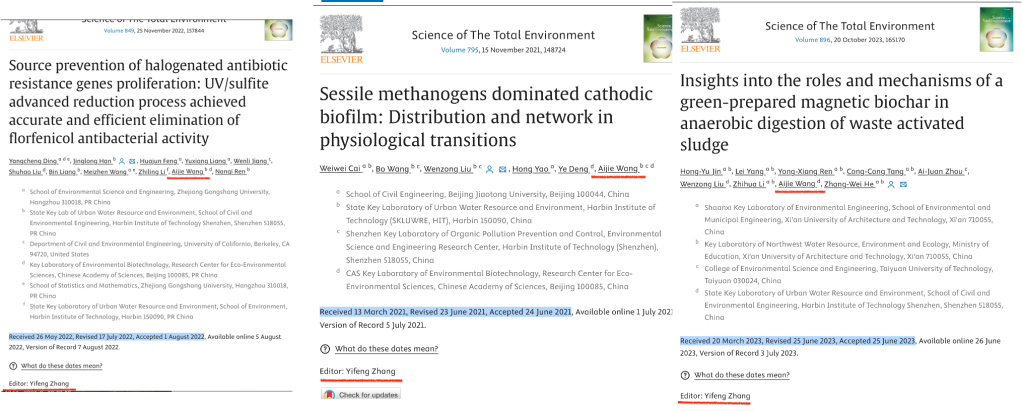
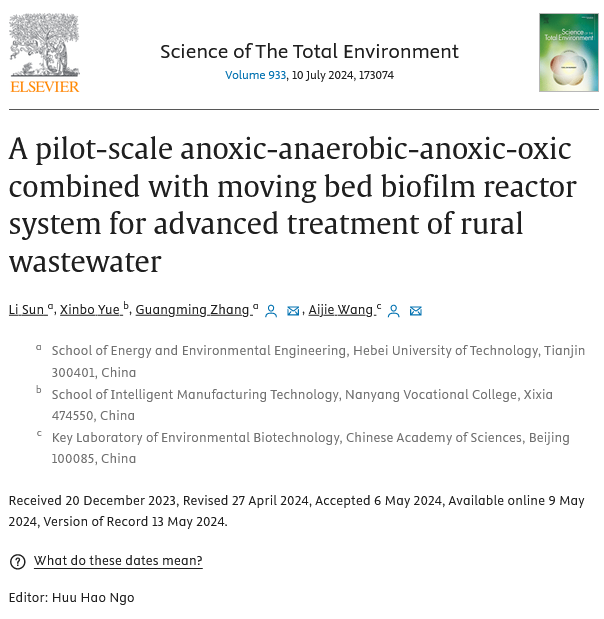
I’m afraid Wang and Zhang are taking the piss and Elsevier doesn’t mind at all.
Elsevier’s research integrity
A Chinese paper gets rejected at Elsevier after reviewer spotted fraud. Same paper re-appears unchanged in another Elsevier journal, the editors refuse any action.
Dear PupPeer user
Elsevier is a gigantic private enterprise and they are extremely good in finding balance between doing nothing and doing a minimum for research integrity so that the academic community doesn’t completely hate them or put them on the same level as MDPI. Also, scientists are generally not afraid of Elsevier, nobody ever gets blacklisted.
The American Chemical Society (ACS) is a non-profit academic entity and they don’t have to please anyone because everyone is already scared shitless of getting blacklisted and destroyed by the academic alpha males who run ACS.
Whitewashed by ACS and Elsevier, Zboril sues Olomouc Dean for “bullying”
“I should remind you that the editorial offices that investigated your allegations did not found any evidence of scientific misconduct or data fabrication. In my opinion, your allegation may bear the elements of defamation and false accusation” – Prof Radek Zboril
So this is what ACS did now. The following paper was reported to their Open Access journal ACS Omega already in August 2022 by the pseudonymous sleuth Cheshire. It is authored by Jolanda Spadavecchia, one of France’s most dishonest chemistry researchers (read December 2022 Shorts), who was completely whitewashed by both her Sorbonne University of Paris and by CNRS, while her whistleblower, Raphael Levy, was put on trial (read April 2023 Shorts):
Fatima Aouidat , Zakaria Halime , Rosalba Moretta , Ilaria Rea , Stefania Filosa , Stella Donato , Rosarita Tatè , Luca De Stefano, Raphaël Tripier , Jolanda Spadavecchia Design and Synthesis of Hybrid PEGylated Metal Monopicolinate Cyclam Ligands for Biomedical Applications ACS Omega (2019) doi: 10.1021/acsomega.8b03266
Actinopolyspora biskrensis: “Figure 4 appears to have two images which overlap.”
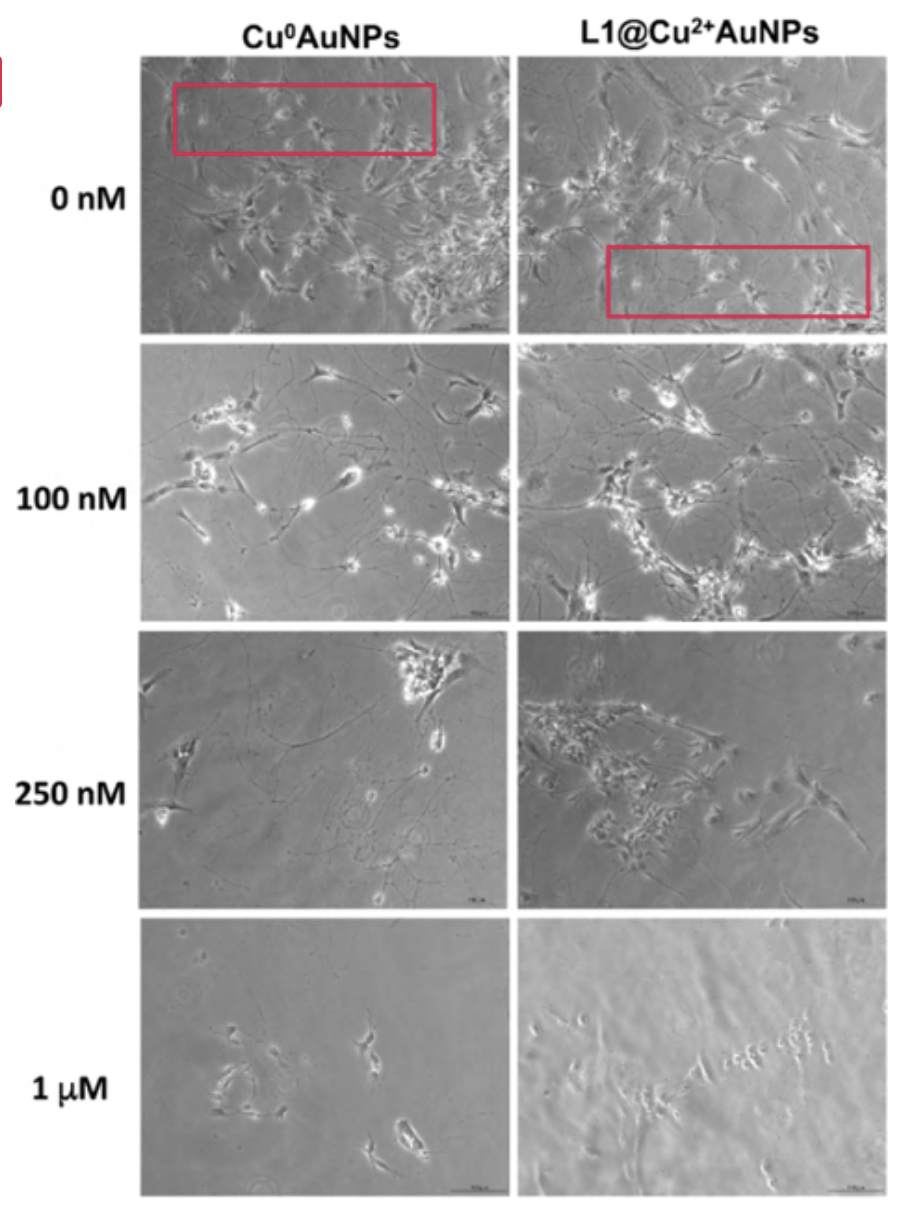
A month later, in September 2022, Cheshire received a reply from Aditi Jain, Development Editor at ACS Omega:
“Please send us specific scientific concerns via email that you wish to raise on the published article in ACS Omega so that we can move forward with the investigation. “
But there was nothing else to send, the picture speaks for itself, same cell microscopy image re-used after a shift for two different nanoparticle experiments. Almost two years passed and on 19 May 2024, Cheshire informed Jain that “Three dozen papers by a common author have comments with concerns post on PubPeer, have corrections, and/or have been retracted” (hyperlink mine).
Right away, Cheshire received this unsigned email from ACS Omega Managing Team:
“We note that the authors have provided an explanation in the post.
If you would still like to request an inquiry, please confirm that we have your consent to share the details of this complaint verbatim with the authors.”
Zombie fingers inside corroded nano-piecrusts
Smut Clyde is back with more fraudulent nanotechnology. This time, he presents the works of Dhanaraj Gopi, who designs fabricated surfaces for surgical implants. In Photoshop, or with a pencil.
Indeed, in April 2021 the middle author Luca De Stefano of Institute for Microelectronics and Microsystems at CNR in Naples, Italy, wrote on PubPeer:
“Usually, I don’t reply to posts or emails from anonymous people or people hiding behind a nickname, especially when these concern observations that cast suspicion rather than create clarity, but in this case for the serenity of my co-authors and readers of the article in question, I will be happy to answer. A part of the two images seems to actually overlap, which means that they belong to two fields of view of the microscope of the same sample which is not by chance the control sample. In the experiment in question, the control sample serves to verify the healthy state of the cells, i.e. neurons from stem cells. Once this was verified, the cells were detached from the multiwell and separated in equal dilutions in different wells in triplicate and then inoculated with different nanocomplexes. Actually, the image of the control sample could have been the same…”
There are several things which are wrong with that reply, and other PubPeer users debunked De Stefano’s claims. E.g., he basically admitted that the authors didn’t have a parallel control group of untreated stem cells. Also, De Stefano pompous drivel contradicts his own Materials and Methods section:
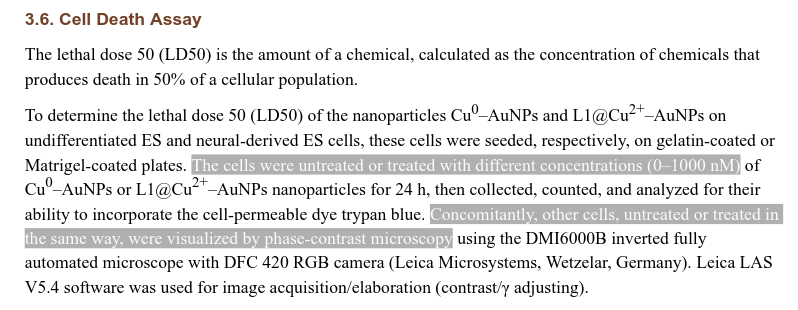
Even if De Stefano was just drunk-talking and the cells were not detached, but cultured as described, with parallel controls – to have acquired only one single image for the control experiment allegedly performed in triplicate is beyond incompetent. Even without Spadavecchia’s PubPeer record, the paper is unreliable.
Possibly of some very distant relevance is that two of Spadavecchia’s retracted papers have De Stefano as significant co-author:
- Jane Politi, Jolanda Spadavecchia, Gabriella Fiorentino , Immacolata Antonucci , Sandra Casale , Luca De Stefano Interaction of Thermus thermophilus ArsC enzyme and gold nanoparticles naked-eye assays speciation between As(III) and As(V) Nanotechnology (2015) doi: 10.1088/0957-4484/26/43/435703
- Jane Politi , Luca De Stefano , Ilaria Rea , Alfredo Maria Gravagnuolo , Paola Giardina , Christophe Methivier , Sandra Casale , Jolanda Spadavecchia One-pot synthesis of a gold nanoparticle–Vmh2 hydrophobin nanobiocomplex for glucose monitoring Nanotechnology (2016) doi: 10.1088/0957-4484/27/19/195701

Both were retracted in March 2023, and IOP Publishing shared the news on PubPeer. the retraction notices (here and here) were similar:
“This article has been retracted by IOP Publishing following an allegation that this article may contain image duplication with another source [1]. IOP Publishing has investigated in line with the COPE guidelines and have found figure 1B is duplicated from another source [1] without disclosure. The authors have provided explanations and offered to make a correction; however, these do not adequately explain the re-use of the image and raise more concerns about the integrity of the work. As such IOP Publishing and the Editor in Chief agree this article should be retracted. IOP Publishing express thanks to the anonymous whistleblower and subject experts who were consulted during the investigation.”
But ACS is above pedestrian ethics and they hate whistleblowers. On 22 May 2024, ACS demanded to know Cheshire’s identity:
“Dear PupPeer user,
Please be assured your identity or emails will not be shared with the authors or anyone else but only the content/nature of the complaint. We need this formal consent to go ahead with the investigation. This is done to ensure the author isn’t held accountable out of nowhere and there is a justified process or scientific reasoning to validate the investigation.”
After Cheshire again reminded ACS that the COPE guidelines contain none of that rubbish, ACS changed their tune: “We’ll investigate it per the COPE and ACS Ethical guidelines, and follow up if there are any questions“.
See, they are more afraid of you than you are of them.
No credible evidence of scientific fraud
At the Wolters-Kluwer-published society journal Shock (which is run by an editorial “mafia” around Chris Thiemermann and Salvatore Cuzzocrea), things are in their usual catastrophic state. You can read July 2023 Shorts to see what the whistleblowers have to fight against at that shockingly rotten journal.
Clare Francis reported the duplicated gel bands of Figure 5B in this paper by Thiemermann himself (who is officially a “Consulting Board Member” at Shock):
Roberta D’Emmanuele Di Villa Bianca , Rosalinda Sorrentino , Emma Mitidieri , Stefania Marzocco , Giuseppina Autore , Christoph Thiemermann , Aldo Pinto , Raffaella Sorrentino Recombinant human erythropoietin prevents lipopolysaccharide-induced vascular hyporeactivity in the rat Shock (2009) doi: 10.1097/shk.0b013e31818909c0
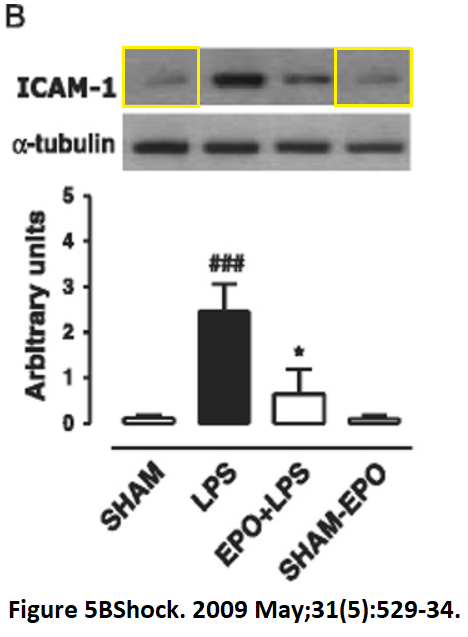
On 20 May 2024, the sleuth received this reply from Shock Editorial Office:
“We investigated your allegation of potential image duplication in Figure 5B […] This investigation included visual inspection of the bands in question and image analysis with Proofig. We conclude that there is no credible evidence of scientific fraud.”
Hahahaha. Proofig, the “AI” image integrity software by Dror Kolodkin-Gal whose main purpose seems to be helping editors to find NOTHING.
Proofig – the Kolodkin-Gal family business
“Don’t let online controversies and aggressive blogs easily ruin everything you’ve worked for to build your reputation […] Whether the image issue is innocent or intentional, the outcome is still the same. Bloggers will attack that publication with image issues, which will damage your reputation and may even lead to a costly investigation. We are…
Here another paper reported to Shock by Aneurus Inconstans, its coauthor is none other but the journal’s Editor-in-Chief Daniel Remick:
Kyros Ipaktchi , Aladdein Mattar , Andreas D. Niederbichler , Laszlo M. Hoesel , Mark R. Hemmila , Grace L. Su , Daniel G. Remick, Stewart C. Wang , Saman Arbabi TOPICAL p38MAPK INHIBITION REDUCES DERMAL INFLAMMATION AND EPITHELIAL APOPTOSIS IN BURN WOUNDS Shock (2006) doi: 10.1097/01.shk.0000225739.13796.f2

On 23 May 2024, the sleuth and the paper’s corresponding author received this message from the Shock Editorial Office:
“Dr. Arbabi,
We are writing to inform you of the outcome of our investigation into allegations of scientific misconduct (specifically, image duplication) in the following manuscript […]
Investigation:
The Publications Committee reviewed Figure 1A and analyzed it with Proofig, which did not find any evidence of image duplication (report attached). The corresponding author indicated that the original images are no longer available, as they were taken 20 years ago, and the lab has since moved institutions. The author maintains the scientific integrity of the work.Conclusion:
No evidence of scientific misconduct was found.We are notifying you, as the corresponding author, the publisher, and the individual who made the allegation, of our findings.”
They used Proofig again! I won’t make jokes about monkeys with hand grenades because in such a comparison it would insult monkeys.
Retraction Watchdogging
Historic heavy rain and flooding
We need an award for the most ridiculous retraction notice. Here, for the category: Authors’ Explanations.
This Chinese papermill product was originally flagged by Elisabeth Bik in July 2022:
Quan-Cheng Kan , Su Zhang , Yu-Ming Xu , Guang-Xian Zhang , Lin Zhu Matrine regulates glutamate-related excitotoxic factors in experimental autoimmune encephalomyelitis Neuroscience Letters (2014) doi: 10.1016/j.neulet.2013.12.031
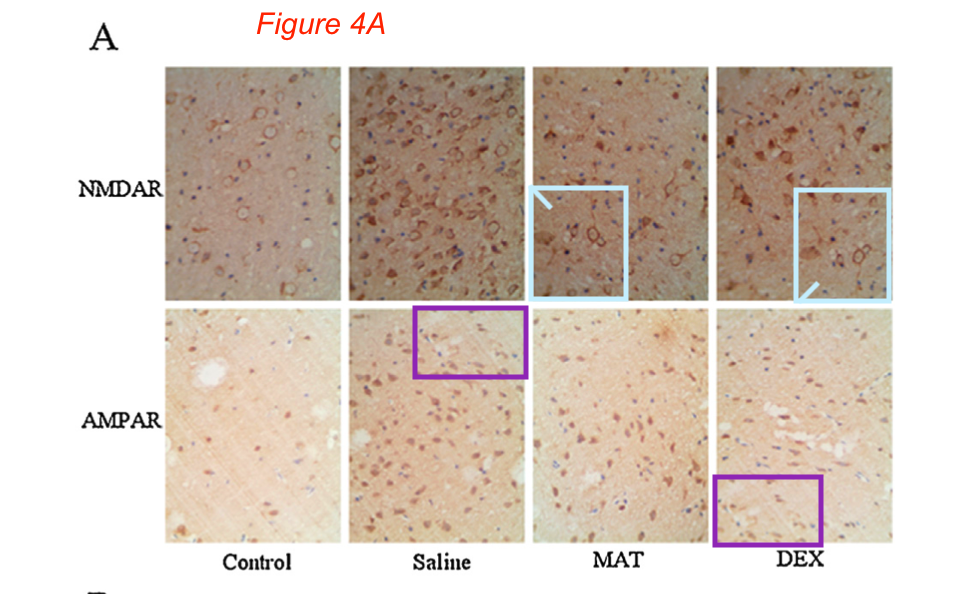
Pale blue boxes: The NMDAR MAT and DEX panels appear to share the same region, albeit shown in mirror image
Purple boxes: The AMPAR Saline and DEX panels appear to share the same region”
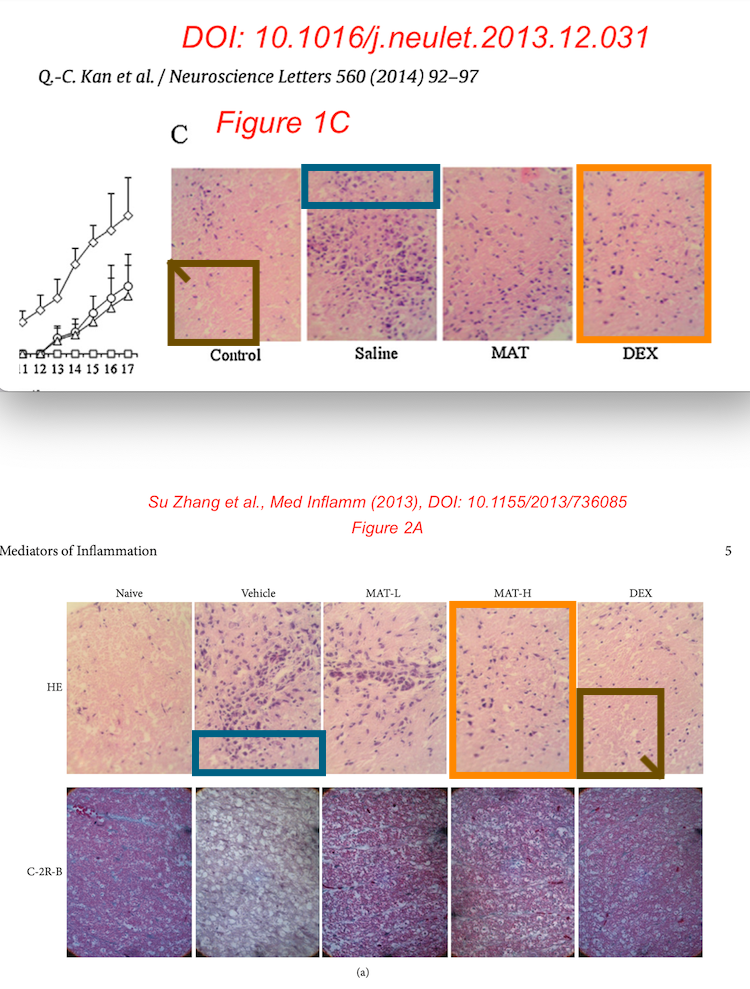
The panels represent one experiment in one paper, and something else in another paper”
The retraction notice was published on 22 May 2024 (highlights mine):
“This article has been retracted at the request of the Editor-in-Chief. Concerns were raised on PubPeer (https://pubpeer.com/publications/C04078E82E53A853E6B5E1D2C7E0DF) regarding overlapping images in 1 figure of this article, and similarities between a figure in this article and another previously published in a different journal [1]. The journal requested the original, unprocessed data for internal assessment. Authors admitted that there were “immunohistology-related mistakes” that occurred during data collection and the arrangement of images. They suggested that these had occurred due to a student mishandling the large numbers of images that were collected and processed. The authors informed the journal that the raw data were lost due to historic heavy rain and flooding in July of 2021 that affected the authors’ city and institution. The authors did offer to submit corrected figures based on new data from other images that were “kept by student who work in other cities” or from new immunohistochemical staining. However, given the time that has passed and the variability that new reagents, tissues, and handling would entail, the Editor in Chief has decided instead to retract the paper. Apologies are offered to readers of Neuroscience Letters that these mistakes were not detected during the submission and review process.”
Hindawi Garbage Sorting System, Based on Citations
Parashorea tomentella continues their investigation of Hindawi’s uneasy collaboration with Chinese papermills. Can it be solved with the promised 511 retractions?
The other paper re-using same data wasn’t retracted because the publisher Wiley needs to keep at least some publications after many thousands were retracted at its defunct brand Hindawi.
Su Zhang , Quan-Cheng Kan , Yuming Xu , Guang-Xian Zhang, Lin Zhu Inhibitory effect of matrine on blood-brain barrier disruption for the treatment of experimental autoimmune encephalomyelitis Mediators of Inflammation (2013) – doi: 10.1155/2013/736085
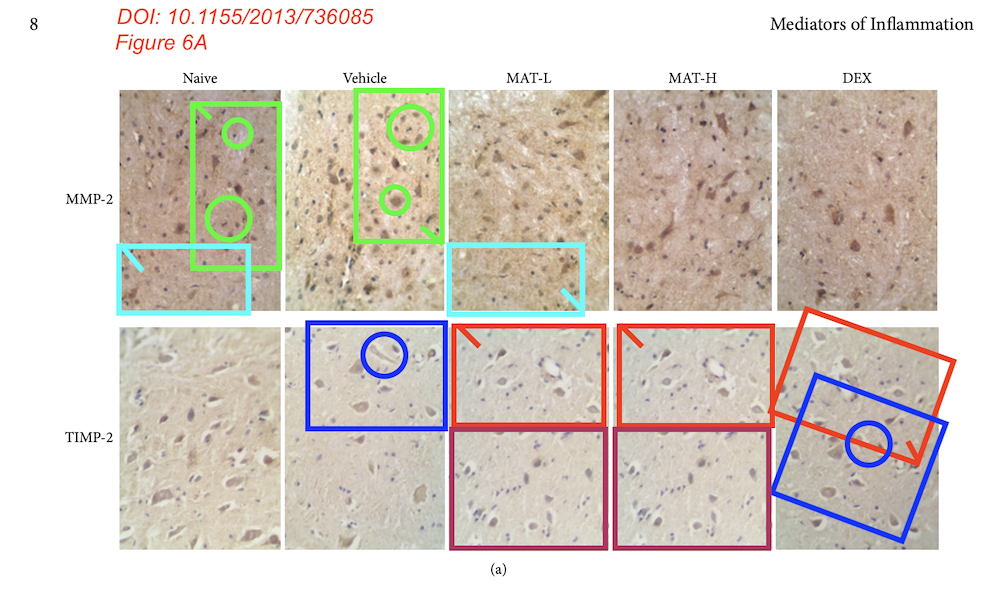
“Concern about Figure 6A. Circles denote areas that are different between the panels – these are not simple duplications, but rather, cells appear to have been added or deleted. Several panels appear to overlap with each other. Three panels in the top row (green and cyan boxes) and four panels in the bottom row (blue and red boxes). The panels are rotated with respect to each other”
Author is deceased
Image integrity sleuth Rene Aquarius killed another paper. He posted the evidence on PubPeer and notified the journal in January 2024.
Ethem Goksu , Ozgur Dogan , Pınar Ulker , Gamze Tanrıover , Esma Konuk , Sayra Dilmac , Ebru Kirac , Necdet Demır , Mutay Aslan Pentoxifylline Alleviates Early Brain Injury in a Rat Model of Subarachnoid Hemorrhage Acta Neurochirurgica (2016) doi: 10.1007/s00701-016-2866-5

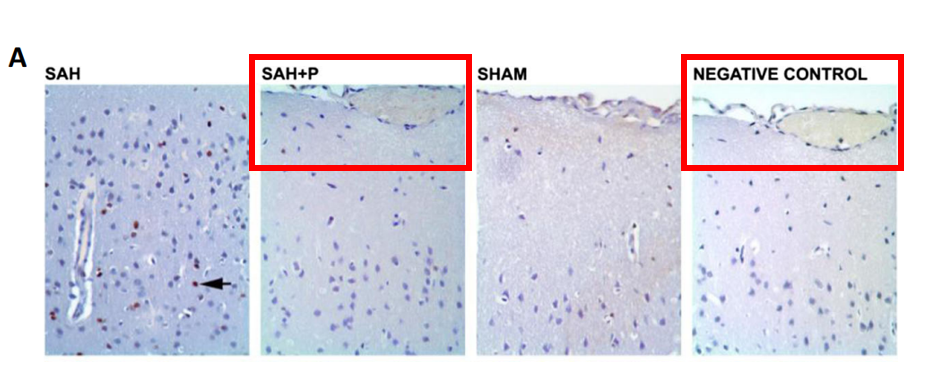
The retraction arrived on 27 May 2024:
“The Editor-in-Chief has retracted this article. After publication, concerns were raised regarding some of the images presented in the figures, specifically:
- In Fig. 2b and c, several panels appear to have repetitive patterns, which are unlikely to occur naturally in electron microscopy images.
- In Fig. 6a, the top row images for SAH + P and Negative Control appear to originate from serial sections of the same sample.
- Also in Fig. 6a, the top two Negative Control images appear to share an overlapping area.
The Corresponding Author has stated that the original data are no longer available. The Editor-in-Chief therefore no longer has confidence in the presented data.
Author Necdet Demır is deceased. None of the other authors have responded to any correspondence from the Publisher about this retraction.”
Necdet Demir was until his death (hopefully not from retraction) professor at the Akdeniz University Faculty of Medicine in Antalya, Turkey. Mutay Aslan seems to have been his protege, she is since 2009 professor at the same university. Maybe this by Aslan also needs retracting?
Hakan Akca, Aydin Demiray , Mutay Aslan , Ibrahim Acikbas , Onur Tokgun Tumour suppressor PTEN enhanced enzyme activity of GPx, SOD and catalase by suppression of PI3K/AKT pathway in non-small cell lung cancer cell lines Journal of Enzyme Inhibition and Medicinal Chemistry (2013) doi: 10.3109/14756366.2011.654114
Elisabeth M Bik: “Figure 3. Red boxes: The left PTEN and AKT panels appear to show partially overlapping blots.”
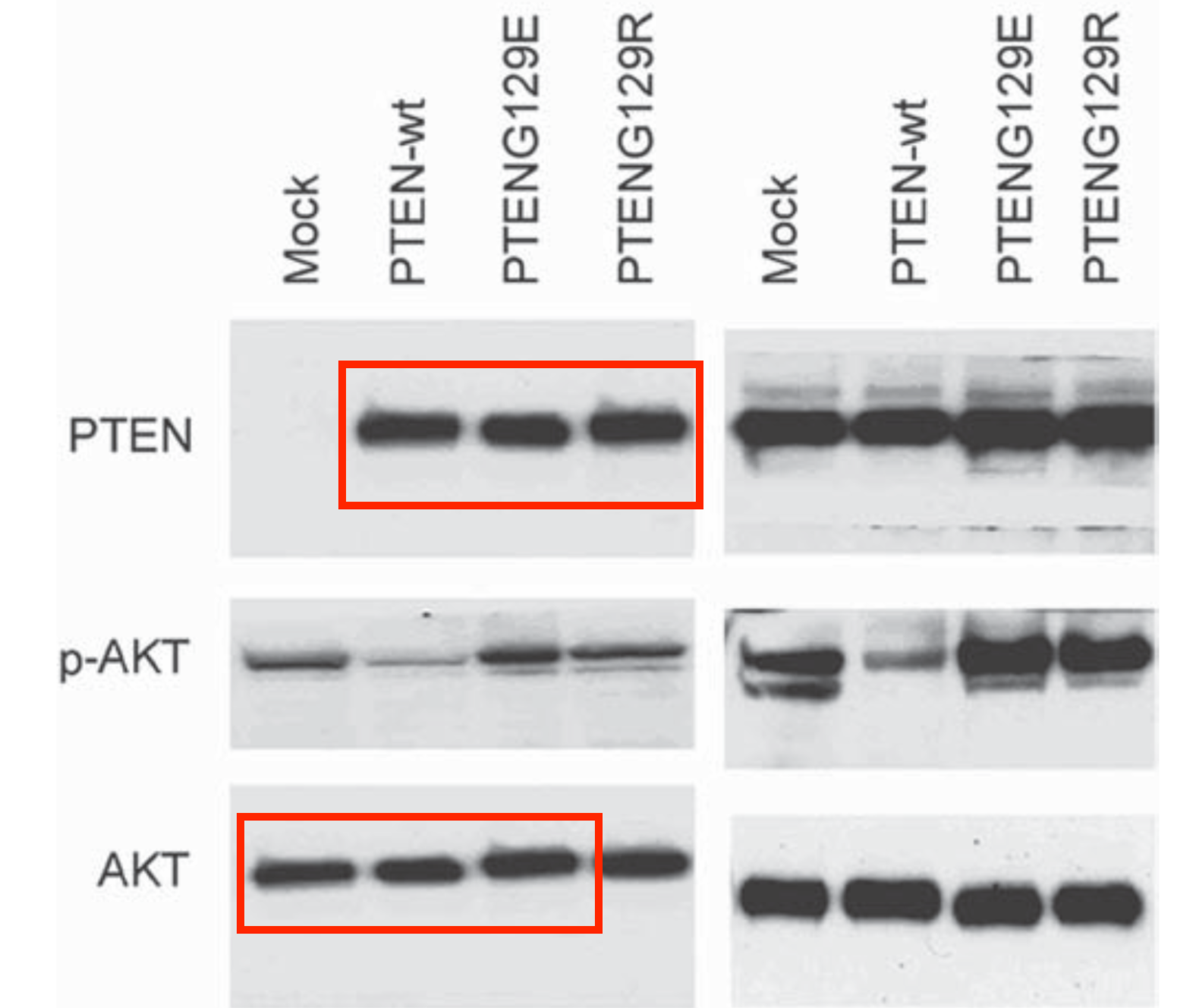
Undeclared re-use of data
Another case of a dead author. A gigantic retraction notice at PLOS One was issued for a paper from Italy which was retracted for both plagiarism and self-plagiarism.
This is the original from 2016, it mentioned: “Sadly, Prof. Paolo Bianco passed away while this manuscript was in revision. We dedicate this study to him“:
Benedetto Sacchetti , Alessia Funari , Cristina Remoli , Giuseppe Giannicola , Gesine Kogler , Stefanie Liedtke , Giulio Cossu , Marta Serafini , Maurilio Sampaolesi , Enrico Tagliafico , Elena Tenedini , Isabella Saggio , Pamela G. Robey , Mara Riminucci, Paolo Bianco No Identical “Mesenchymal Stem Cells” at Different Times and Sites: Human Committed Progenitors of Distinct Origin and Differentiation Potential Are Incorporated as Adventitial Cells in Microvessels Stem Cell Reports (2016) doi: 10.1016/j.stemcr.2016.05.011
It has Giulio Cossu and Maurilio Sampaolesi as coauthors, but for a change, they are the victims of research misconduct here!
How Sampaolesi and Cossu cured Muscular Dystrophy with stem cells
Gather round children, and hear a fairy tale from the golden age of degenerative medicine.
Here is the now retracted copy at PLOS One which was published a year later. The first author Benedetto Sacchetti (professor at University of Turin) became last author, Alessia Funari (professor at Sapienza University of Rome) remained second author, and two new people joined as first and third authors:
Tiziana Persichini , Alessia Funari , Marco Colasanti , Benedetto Sacchetti Clonogenic, myogenic progenitors expressing MCAM/CD146 are incorporated as adventitial reticular cells in the microvascular compartment of human post-natal skeletal muscle PLoS ONE (2017) doi: 10.1371/journal.pone.0188844
The long read of the retraction was published on 20 May 2024 (spotted by Smut Clyde):
“Following publication of this article [1], concerns were raised about undeclared re-use of data from an earlier study [2] by some of the same authors.
The study reported in [1] appears to overlap with work reported previously in [2] (which was published under a CC BY-NC-ND 4.0 license), including in methodology, results and conclusions.
Related to the overlap in experimental work, some images in [1] are based on the same tissue/cell samples reported in [2]. The reuse of samples and/or images was not declared in [1].
- The fluorescence microscopy image in Fig 1A of [1] shows the same cell as is shown in S4E Fig panel g of [2]. Corresponding author BS has stated that these two images are separately captured images of differing magnification, showing the same tissue sample.
- The skin fibroblast image panel in Fig 3B of [1] appears similar to the cord blood image in Fig 4Ac of [2]. Corresponding author BS has stated that the image used for the cord blood panel in Fig 4Ac of [2] is incorrect, and the PLOS ONE figure panel is correctly labelled as skin fibroblasts.
- In Fig 4C of [1], the two image panels labelled “myoglobes and myofibers” in the second and third rows appear similar to the MU “MSCs” image panels of Fig 5Eb and 5Ea of [2], respectively. Corresponding author BS has indicated that the images used in Fig 4C of [1] are separately captured images of the same harvested Matrigel section as shown in Fig 5Ea and 5Eb of [2], with different magnifications.
- In Fig 4B of [1], the lower right-hand Matrigel image panel with scale 10μm (described in the caption as human dermal-derived fibroblasts) is incorrect and is a higher magnification image of the same tissue shown in the BM “MSCs” Matrigel image panel in Fig 5Fb of [2].
- A region on the right-hand side of the hSpectrin Laminin Dapi panel of Fig 5D of [1] reported to show myofibers of SCID/beige/CTX (cardiotoxin) injured mice, when flipped vertically and rotated appears similar to part of the lower right-hand panel of Fig 5D of [2] reported to show myofibers from SCID/mdx mice.
In response to these concerns, corresponding author BS indicated that the study reported in [2] was a preliminary approach to questions around non-canonical myogenic progenitors and that the PLOS ONE article [1] addressed further pending questions, offering advances including:
- A direct comparison of the explant culture vs CD-146+-enriched populations, in terms of myogenic potential, frequency of myogenic cells and expression of markers; and
- The finding that in vivo transplanted human muscle-derived CD146+ multi-clonal cell strain immunoreactivity of CD146 was restricted to microvascular walls of the interstitial tissue.
A member of the Editorial Board advised that there is substantial overlap in the methodology and findings presented in these two articles [1,2], including several instances of duplicated data reported from the same experiments and samples. They noted that while there are some experimental results that are newly described in the PLOS ONE article [1], those results are insufficient to support a standalone article if the overlapping content is disregarded.
In light of the concerns about the extent of the overlapping content and the undeclared re-use of experimental data from [2], the PLOS ONE Editors retract this article because it does not satisfy the journal’s second publication criterion or PLOS’ policy on Submission and Publication of Related Studies.
Of note, three additional issues arose in regard to this article [1]:
- The study approval by the Research Ethics Committee of Istituto Superiore di Sanità of Rome (approval date September 20, 2016; Prot. PRE-686/16) was incorrectly reported in this article and does not apply to the work reported in [1]. The corresponding author BS has indicated that an earlier version of the manuscript reported the human muscle samples were collected with patient consent as surgical waste following orthopedic surgery. The principal investigator for the study has passed away, and corresponding author BS has indicated that they hold no further information about ethical oversight or patient consent for the work. Hence, this issue remains unresolved.
- The article’s Funding statement as published is incorrect. The corresponding author BS has indicated that the correct statement was: The first phases of this work were supported by a Genostem grant (LHSB-CT-2003-503161) to Prof. Paolo Bianco. The funders had no role in study design, data collection and analysis, decision to publish, or preparation of the manuscript.
- There are also several references to “Data not shown” in support of statements in the originally published article, which is not permitted under PLOS ONE’s editorial policies. The corresponding author BS provided these data for editorial consideration, and so this issue could have been resolved.
The Fig 1A, Fig 3B skin fibroblasts panel, Fig 4C myoglobes and myofibers panels, Fig 4B lower right-hand Matrigel panel, and Fig 5D hSpectrin Laminin Dapi panel results report material similar to that published in [2] in 2016 by Sacchetti et al. under a CC BY-NC-ND 4.0 license. Due to restrictions that apply to the original article’s license, these figures are excluded from the PLOS article’s [1] CC BY 4.0 license. At the time of retraction, the article [1] was republished to note this exclusion in the Figure legends and the article’s copyright statement.
TP and MC agreed with the retraction. AF and BS either did not reply directly or could not be reached.”
Who killed Margarita Lorenzo’s reputation?
“I do not who is doing this, who is behind this. Papers were not manipulated, please believe me. Someone must want my scientific death. This is scaring Believe me please. I am a modest scientist.”
To me it looks like Professor BS bullshitted in every instance. It is very worrying that also the original Stem Cell Reports study lacked an ethics approval and patient consent, indeed the Sacchetti et al 2016 paper merely says: “Samples were obtained with informed consent according to institutionally approved protocols.”
Obviously some whistleblowers have been fighting since 2017 to get this plagiarised paper retracted. They succeeded 7 years later.
Industry Giants
A complete surprise
ProPublica has a long read by Sharon Lerner on how the chemistry company 3M Corporation covered up the global fluorochemical pollution which it caused. These are also called “forever chemicals”. It is a story of the company’s chemist and a whistleblower, Kris Hansen.
In 1997, Hansen received an assignment from her boss Jim Johnson: “to test human blood for chemical contamination” with the fluorochemicals PFOS (perfluorooctanesulfonic acid), which she was told “often found its way into the bodies of 3M factory workers” but was harmless. PFOS are presently called PFAS (per- and polyfluoroalkyl substances).
“The lab had just reported something odd, however. For the sake of comparison, it had tested blood samples from the American Red Cross, which came from the general population and should have been free of fluorochemicals. Instead, it kept finding a contaminant in the blood. […]
Hansen didn’t want to share her results until she was certain that they were correct, so she and her team spent several weeks analyzing more blood, often in time-consuming overnight tests. All the samples appeared to be contaminated. When Hansen used a more precise method, liquid chromatography, the results left little doubt that the chemical in the Red Cross blood was PFOS.
Hansen now felt obligated to update her boss. […] his response was cryptic. “This changes everything,” he said. Before she could ask him what he meant, he went into his office and closed the door. […]
In the middle of this testing, Johnson suddenly announced that he would be taking early retirement.”
Thing is, 3M knew that PFOS compounds are toxic.
“What Hansen didn’t know was that 3M had already conducted animal studies — two decades earlier. They had shown PFOS to be toxic, yet the results remained secret, even to many at the company. […] Hansen’s bosses never told her that PFOS was toxic. In the weeks after Johnson left 3M, however, she felt that she was under a new level of scrutiny.”
The 28 year old chemist was then constantly gaslighted with accusation that all her findings were false, it can’t be that every blood sample she tested contained PFOS. Hansen kept testing all possible blood samples in order to find a negative one and prove her competence. But:
“She studied the blood of hundreds of people from more than a dozen blood banks in various states. Each sample contained PFOS. The chemical seemed to be everywhere. […]
One afternoon in 1998, a trim 3M epidemiologist named Geary Olsen arrived with several vials of blood and asked her to test them. The next morning, she read the results to him and several colleagues — positive for PFOS. As Hansen remembers it, Olsen looked triumphant. “Those samples came from my horse,” he said […]
Hansen and her team ultimately found PFOS in eagles, chickens, rabbits, cows, pigs and other animals. They also found 14 additional fluorochemicals in human blood, including several produced by 3M.”
Only when Hansen’s lab analysed blood collected before 3M created PFOS compounds, the samples finally tested negative. It seems, the 3M products Scotchban and Scotchgard were the sources of PFOS contamination. And the company knew, as Hansen found out after speaking to a 3M employed author of an obscure 1981 article which described a method for measuring fluorine in blood.
Environmental Pseudoscience and Polluted Research
“We are living in a faked world and there is a lot of un-verified avatars. “, Philippe Garrigues, EiC
In in early 1999, Hansen was invited to present her findings to 3M’s CEO, Livio D. DeSimone. He fell asleep during her presentation, while other top executives “seemed to view her diligence as a betrayal: Her data could be damaging to the company.” And then:
“After that meeting, Hansen remembers learning from Bacon that her job would be changing. She would only be allowed to do experiments that a supervisor had specifically requested, and she was to share her data with only that person. She would spend most of her time analyzing samples for studies that other employees were conducting, and she should not ask questions about what the results meant.”
Hansen became a pariah in her company, her colleagues even stopped greeting her. In May 1998, 3M officials informed FDA about Hansen’s PFOS findings without telling her or crediting her. The company still insisted PFOS were harmless.
“A year after Hansen’s meeting with the CEO, 3M, under pressure from the EPA, made a very costly decision: It was going to discontinue its entire portfolio of PFOS-related chemicals. In May 2000, for the first time, 3M officials revealed to the press that it had detected the chemical in blood banks. One executive claimed that the discovery was a “complete surprise.”
I thank all my donors for supporting my journalism. You can be one of them!
Make a one-time donation:
I thank all my donors for supporting my journalism. You can be one of them!
Make a monthly donation:
Choose an amount
Or enter a custom amount
Your contribution is appreciated.
Your contribution is appreciated.
DonateDonate monthly







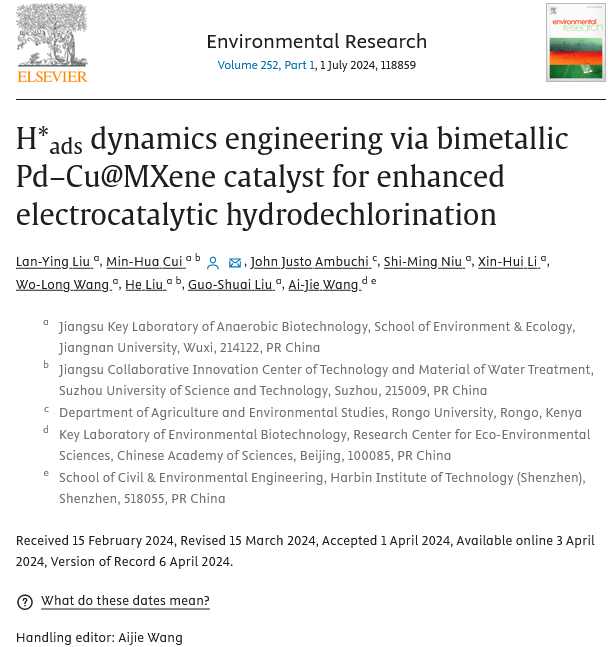







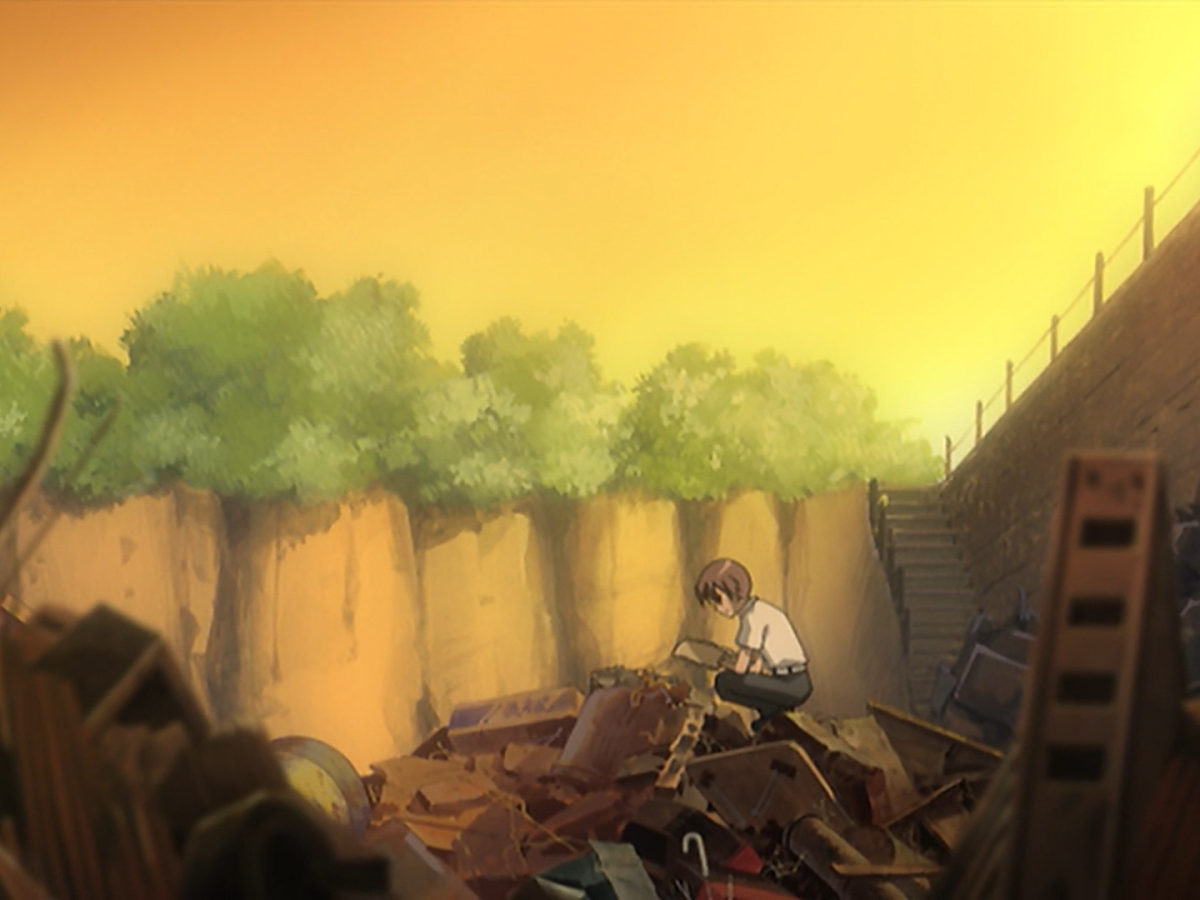




“Well, he is Cheshire on Twitter and on For Better Science and Actinopolyspora biskrensis on PubPeer.” Clearly a schizophrenic (if that is still allowed to be said).
Hilarity will no doubt ensue. Thank you for all that you do.
LikeLiked by 1 person
There’s also an anonymous PubPeer user…
LikeLike
I’m pretty sure agronomists can be experts wrt erectile dysfunction. What’s the problem there?
LikeLiked by 1 person
Someone has apparently mixed up the literal and metaphorical meaning of the Russian idiom “вялый хрен,” it seems
LikeLiked by 1 person
On a more serious note, the section dealing with Kris Hansen by Sharon Lerner is noteworthy. For context, here are Sharon’s earlier articles on C8 (PFAS), DuPont, and 3M that do not focus on Hansen.
https://theintercept.com/series/the-teflon-toxin/
Back in 2015 her reporting instantly reminded me of (brief version)…
The discovery that leaded fuels were poisoning the planet can be attributed to the work of American geochemist Clair Cameron Patterson. In the mid-20th century, Patterson conducted pioneering research that revealed the extent of lead pollution resulting from the use of tetraethyllead in gasoline.
Patterson’s interest in lead began with his efforts to determine the age of the Earth. While conducting this research, he noticed that his samples were being contaminated by unexpected amounts of lead. This observation led him to investigate the sources of environmental lead contamination.
In 1965, Patterson published a landmark paper that demonstrated the widespread contamination of the environment by lead from gasoline. His research showed that the levels of lead in the atmosphere had dramatically increased since the introduction of leaded gasoline in the 1920s. He also highlighted the health risks associated with lead exposure.
Patterson’s work faced significant opposition from industry groups and some scientists, but his persistent efforts eventually led to greater public awareness and policy changes. His findings were instrumental in the eventual phase-out of leaded gasoline in many countries, starting in the 1970s and 1980s. The United States began phasing out leaded gasoline in 1975, with a complete ban in 1996.
Back in 2015, her reporting instantly reminded me of…
LikeLike
1) “Do western university leaders like those in Darmstadt really think Iranian university graudates are magnitudes better than those in the rest of the world, because of Aryan genetics or superior theological education by the Revolutionary Guards?”
2) “Or do they understand exactly what’s going on, but see their high-publishing Iranians as a mean to extract even more money from the public coffers?”
I would like to answer this question: 1. Sorry, I changed my mind, 2. No, 1. Or 2? Sht, it’s too hard. Btw, they will accuse you of rcism again because of these questions.
LikeLike
Some papermill fraudster using a stolen identity of Drexel University researcher Yuri Gogotsi was shit-posting here as is now banned, his comments deleted. His IP address was in Dubai.
Especially he was keen to defend Mo Arjmand:
“Not sure why you do not want to learn that Dr. Arjmand is among the really good ones. Using AI to find non-sense in someones’s papers is not a right strategy, unless you and your friend have other intentions.”
LikeLike
Regarding Proofig, Scholarly Kitchen gave space to Dror Kolodkin-Gal for a rather hagiographic self-promotion of Proofig. Someone left a comment saying something like ‘this is relevant I think’ with a link to your post, https://forbetterscience.com/2023/02/14/proofig-the-kolodkin-gal-family-business/. Within a few hours the comment was removed and the SK post now shows zero comments.
LikeLike
Oh wow. Actually Scholarly Kitchen tried to hide Dror’s little COI and forgot to reveal that he is not an academic scientist as they initially presented him, but a businessman who owns Proofig. After my colleague posted that comment, they changed the COI statement at the beginning.
And later on, they deleted my colleague’s comment, as you noticed.
LikeLike
Aijie Wang and Harbin institute are trying to stop the spreading of her unethical editorial tasks. A Chinese blog that wrote about it has been asked take the info down: https://x.com/Dr_5GH/status/1796314370005451118
LikeLike